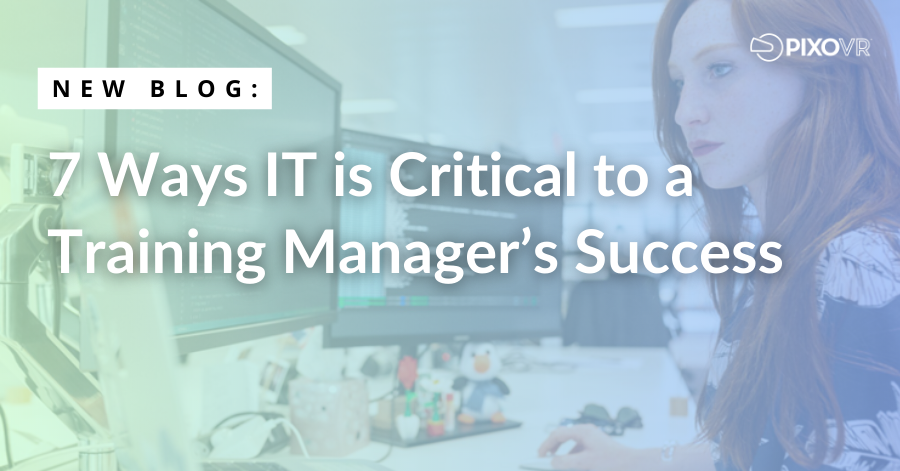For more information and to take a deeper dive into VR and how it could work for your organization, check out our FREE whitepapers, here!
There is a lot of new technology that training managers are being asked to incorporate into corporate training. One of the most challenging, yet rewarding, is virtual reality (VR). VR has been proven to be incredibly effective at helping employees practice skills in a safe, realistic environment. This is true for both hard and soft skills. But figuring out how to use VR can be overwhelming for training managers who haven’t had much exposure to implementing a new technology.
In fact, the most common point of failure for training managers trying to implement VR into their training programs is trying to do it without IT resources. Instead, training managers need to invest in a relationship with IT to make the process smooth and avoid frustration. This article covers seven ways that IT is critical for successfully implementing VR.
7 critical tasks for IT in VR training implementations
- Purchasing and registering the devices
In order for corporate VR training to work, it needs to be run on headsets that work in corporate environments. For instance, some headsets have an exclusive system that doesn’t work well in corporate environments. IT can help evaluate headsets and ensure that they will work with your training content and work within the corporate environment. IT can also register and manage the devices. This is something that IT already has processes for so it is easiest to let them handle that aspect of your program.
- Purchasing and configuring software
The best way to ensure success with VR is to use VR software that can host the content, wirelessly deliver it to headsets, and monitor usage and results. IT should be involved in the evaluation and buying process for this software. They are also essential during implementation to ensure the software is configured to work in the corporate environment.
- Verifying SOC compliance
Ensuring that the technology you are bringing in for VR meets the security requirements the company has is an important part of ensuring there are no issues down the road with compliance. IT has a process for this and must be included early in the buying process in order to run their safety checks.
- Testing the software devices
One of the most common frustrations for training managers is trying to get VR to work with the company firewall. This points to the criticality of having IT involved to help test the VR headsets and VR software running through different scenarios of use. These scenarios might include headsets at different company locations or remote locations. It can also include sending the content wirelessly, operating a training course, and tracking the results in the software. IT should execute the testing and troubleshoot any issues.
- Creating documentation (if needed)
If the training involves sending headsets to employees to use independently of the training manager, it is best to create documentation to ensure users have the steps/knowledge to work the system independently. IT is used to technical documentation and is a great resource to help draft this.
- Setting up support for VR
VR is technology that will likely be new for many employees and training managers. There will be questions and assistance will be needed at times to troubleshoot issues. Training managers need to work with IT to incorporate basic help into the IT help desk. It is particularly important to understand how the headsets operate and resources for troubleshooting issues as this is one of the most common support issues. Having the IT help desk trained will prevent training managers from being overwhelmed with questions they can’t answer. The IT help desk should be empowered with the ability to contact headset and software vendors as needed for higher tier support.
- Integrating with LMS
It’s great that VR software can track the results of the VR training, but if a training program uses a Learning Management System, integrating your VR software with your LMS makes for a seamless management and data experience. IT can work with vendor APIs to connect the systems and streamline training data.
It’s time to make friends with IT
Coordination with IT may take some backing from senior leadership, but once all the players understand the short and long term value of VR training, the easier it will be to get the resources needed. Share with leadership what other companies are doing with VR training to both inspire as well as remind that incorporating VR into training isn’t a passing trend, but one that is cutting costs and adding significant value to large corporations. And if all that fails, bribing IT with food is always a solid way in!
Once you get the support you need from IT, it will be much easier to make VR a regular part of your training program.
Need help figuring out how to roll out VR as part of your training program? Here’s a guide to help you get started.
Need help getting VR right? PIXO VR can help. Click here to arrange a meeting with a VR expert.


Leave a Reply
You must be logged in to post a comment.